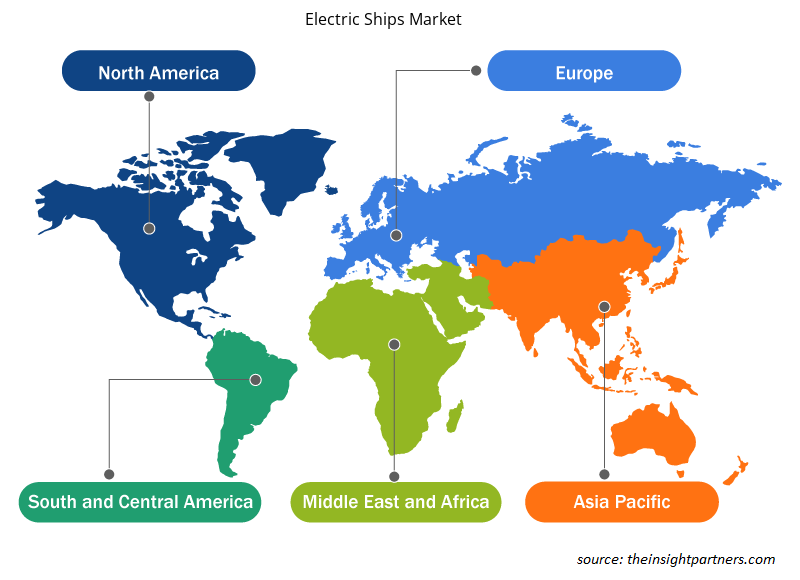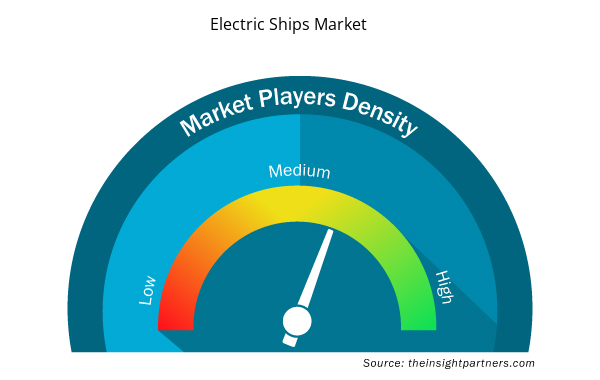2021 年电动船舶市场价值为 38.2 亿美元,预计 2021 年至 2028 年的复合年增长率为 10.3%。
电动船是指以电力驱动系统为主要推进技术的任何船舶。它可以是全电池电动、氢燃料电池电动、电动混合动力船,从拖船、渡轮、货船和驳船到游船、渔船、游艇和无人水下航行器 (UUV)。与传统的柴油发动机船不同,电动船是电力驱动的。这些船使用电池存储装置作为电源来驱动电动机。电动船可以使用多种类型的电池,包括锂离子电池、铅酸电池和燃料电池。电动船主要是内陆水道上的渡轮和小型客船,完全依靠电力航行。它们一次充电只能行驶很短的距离,约 80 公里。此外,太阳能船也用于需要低功率输出的轻型船舶。然而,由于重量大,货船的功率需求无法通过全电动系统满足;因此货船使用的是混合柴油电力系统。
定制此报告以满足您的需求
您可以免费定制任何报告,包括本报告的部分内容、国家级分析、Excel 数据包,以及为初创企业和大学提供优惠和折扣
- 获取此报告的关键市场趋势。这个免费样品将包括数据分析,从市场趋势到估计和预测。
COVID-19 疫情对电动船舶市场的影响
COVID-19 疫情对电动船舶市场产生了不利影响。此次疫情对全球人类流动产生了前所未有的影响。在海洋中,由于对人类流动的严格限制和商品消费的变化,船舶活动受到影响。一些国家因 COVID-19 疫情关闭了邮轮业。不过,一些邮轮公司正试图在疫情期间恢复运营。COVID-10 疫情彻底改变了人类的海洋活动,据报道港口限制和消费模式的转变影响了多个海事部门、渔业、客运渡轮和游轮。然而,在某些地区,货物运输在封锁期间被宣布为必不可少的,这为电动船舶市场创造了一个有利可图的机会。
电动船舶市场洞察
船舶改装中混合动力和电力推进系统的采用率上升
船舶改装越来越受到人们的关注,并吸引船东/造船商延长现有船舶的使用寿命。这种过程提供了一个减少燃料消耗的机会,并且作为一种经济有效的程序,可以随时了解最新的环保解决方案。改装正在成为海运业的常见做法。造船商正在走向自动化,整合新建船舶,并为现有船舶改装混合动力和电力推进系统。该系统是改装具有巨大改装潜力的过时船舶的便捷选择,包括渡轮、集装箱船、游轮、拖船和普通货船。造船商选择为船舶改装混合动力电力推进系统或全电动推进系统,因为这比购买新船相对便宜。此外,一些欧洲造船商正在积极为其现有船队改装混合动力和电力推进系统。例如,根据 Riviera Maritime Media Ltd 发表的文章,2020 年 3 月,海上供应船 (OSV) 船东投资改装柴油电力/液化天然气驱动船队,采用电池混合动力推进系统,此举对租船人、船东和挪威的环境问题都产生了回报。这些因素导致采用混合动力和电力推进系统来改装船舶。
基于类型的市场洞察
根据类型,电动船舶市场细分为电池电动船舶、插电式混合动力船舶和混合动力船舶。混合动力船舶细分市场在 2020 年引领了市场。混合动力船舶提供的可靠性支持了其需求,因为它使用了辅助推进系统和更高的速度,这可以降低故障风险并在更短的时间内覆盖更大的距离。此外,混合动力船舶推进可以通过两种方式推进——电力(通过柴油电力或电池供电)或机械(直接柴油驱动)。此外,全球的船东或航运和物流公司更喜欢混合动力船舶,因为它们可以降低燃料消耗并有助于降低运营成本。在低功率下使用柴油电力推进器,在需要高功率(即在不同速度条件下在内陆水域航行)时使用直接柴油驱动推进器,可以降低电动船舶的运营成本。这是一种更智能的方式,可以使用混合动力船舶推进器来利用可用能源并节省燃料成本。
电动船舶市场的参与者采取合并、收购和市场计划等策略来维持其市场地位。以下列出了一些主要参与者的发展。
- 2021 年 11 月,BAE Systems 推出了下一代电力和推进系统,以帮助船舶运营商实现零排放。它提供了一种灵活的解决方案,可提高电气效率和船舶续航里程,增加推进功率并简化安装。
- 2020 年 9 月,Kolumbus(一家交通公司)和 Fjellstrand(造船商)签署了交付世界上第一艘全电动快速渡轮的合同。该项目获得了欧盟“地平线 2020”研究和创新计划的资助。
根据类型,电动船舶市场分为电池电动船舶、插电式混合动力船舶和混合动力船舶。根据功率,电动船舶市场细分为小于 75 千瓦、75-150 千瓦、151-745 千瓦、746-7560 千瓦和大于 7560 千瓦。根据续航里程,电动船舶市场分为小于 50 公里、50-100 公里、101-1000 公里和大于 1000 公里。根据船舶类型,电动船舶市场细分为邮轮、渡轮、油轮、散货船、渔船、驱逐舰、航空母舰和其他。按地理位置划分,电动船舶市场分为五大地区——北美、欧洲、亚太地区 (APAC)、中东和非洲 (MEA) 和南美 (SAM)。
电动船舶市场区域洞察
Insight Partners 的分析师已详细解释了预测期内影响电动船舶市场的区域趋势和因素。本节还讨论了北美、欧洲、亚太地区、中东和非洲以及南美和中美洲的电动船舶市场细分和地理位置。

- 获取电动船舶市场的区域特定数据
电动船舶市场报告范围
| 报告属性 | 细节 |
|---|---|
| 2021 年市场规模 | 38.2亿美元 |
| 2028 年市场规模 | 77.6亿美元 |
| 全球复合年增长率(2021 - 2028) | 10.3% |
| 史料 | 2019-2020 |
| 预测期 | 2022-2028 |
| 涵盖的领域 | 按类型
|
| 覆盖地区和国家 | 北美
|
| 市场领导者和主要公司简介 |
|
电动船舶市场参与者密度:了解其对业务动态的影响
电动船舶市场正在快速增长,这得益于终端用户需求的不断增长,而这些需求又源于消费者偏好的不断变化、技术进步以及对产品优势的认识不断提高等因素。随着需求的增加,企业正在扩大其产品范围,进行创新以满足消费者的需求,并利用新兴趋势,从而进一步推动市场增长。
市场参与者密度是指在特定市场或行业内运营的企业或公司的分布情况。它表明在给定市场空间中,相对于其规模或总市场价值,有多少竞争对手(市场参与者)存在。
在电动船舶市场运营的主要公司有:
- 英国航太系统公司
- 达菲电动船公司
- 菲耶尔斯特兰德
- X 岸边
- 通用动力电动船
免责声明:上面列出的公司没有按照任何特定顺序排列。

- 了解电动船舶市场的主要参与者概况
公司简介
- 英国航太系统公司
- 达菲电动船公司
- 菲耶尔斯特兰德
- X 岸边
- 通用动力电动船
- 海达路德
- MAN 能源解决方案
- 港口班轮公司
- 西门子能源
- 瓦德
- 历史分析(2 年)、基准年、预测(7 年)及复合年增长率
- PEST 和 SWOT 分析
- 市场规模价值/数量 - 全球、区域、国家
- 行业和竞争格局
- Excel 数据集



Report Coverage
Revenue forecast, Company Analysis, Industry landscape, Growth factors, and Trends

Segment Covered
This text is related
to segments covered.

Regional Scope
North America, Europe, Asia Pacific, Middle East & Africa, South & Central America

Country Scope
This text is related
to country scope.
常见问题
The idea of retrofitting ships is gaining interest and is attracting shipowners/shipbuilders to extend the lifetime of their existing ships. Such a process provides a chance to reduce fuel consumption and stay up to date with the latest eco-friendly solutions as a cost-effective procedure. Retrofitting is becoming a common practice in the maritime industry. Shipbuilders are moving toward automation, integrating new build ships, and retrofitting existing ships with hybrid and electric propulsion systems. A hybrid-electric propulsion system is a convenient choice for retrofitting outdated ships. Ships have a large retrofit potential, including ferries, container vessels, cruise ships, tugboats, and general cargo ships. Shipbuilders choose to retrofit ships with a hybrid-electric propulsion system or a fully electric propulsion system as it is a relatively cheaper option than purchasing a new ship. These factors mentioned above have resulted in the adoption of hybrid and electric propulsion systems for retrofitting ships.
Nowadays, hybrid propulsion technology is commonly used for small vessels such as ferries. For instance, according to the article published by the Institution of Engineering and Technology, in January 2019, the UK shipbuilder Ferguson Marine had built Catriona, a £12.3 million (US$ 15.82 million) diesel-electric-battery-power hybrid ferry for CalMac to use on its Clyde and Hebridean routes. However, with the development of marine electric propulsion technology and alternative fuels such as fuel cells, there is a massive opportunity for manufacturers to work on hybrid-electric propulsion systems for larger ships. The stricter emissions targets have encouraged shipbuilders to install a hybrid propulsion system on existing or new vessels. The research & development (R&D) department for ABB marine activities in Norway stated that the hybrid propulsion systems significantly reduce both fuel consumption and emissions, according to the article published by the Institution of Engineering and Technology in January 2019. Therefore, with the growing emission control norms, the adoption of hybrid-electric propulsion systems is increasing among larger ships, creating a massive opportunity for manufacturing larger ships using hybrid-electric propulsion systems.
Europe dominated the Electric Ships market in 2020 with a share of 48.6% and is expected to continue its dominance by 2028. North America is the second-largest contributor to the global Electric Ships market in 2020, followed by Asia Pacific.
The major companies in Electric Ships market are BAE Systems, Duffy Electric Boat Company, Fjellstrand AS, X Shore, General Dynamic Electric Boat, Hurtigruten, MAN Energy Solutions, PortLiner, Siemens Energy, and VARD AS
The major Application in Electric Ships includes cruise ship, ferries, tankers, bulk carriers, fishing vessels, destroyers, aircraft carriers, and others. In terms of market share, the electric ships market was dominated by the ferries segment in 2020.
The electric ships market, by type is segmented into battery electric ships, plug-in hybrid electric ships, and hybrid electric ships. The Electric Ships market was dominated by the hybrid electric ships segment in 2020.
Trends and growth analysis reports related to Automotive and Transportation : READ MORE..
The List of Companies - Electric Ships Market
- BAE Systems
- Duffy Electric Boat Company
- Fjellstrand AS
- X Shore
- General Dynamic Electric Boat
- Hurtigruten
- MAN Energy Solutions
- PortLiner
- Siemens Energy
- VARD AS
The Insight Partners performs research in 4 major stages: Data Collection & Secondary Research, Primary Research, Data Analysis and Data Triangulation & Final Review.
- Data Collection and Secondary Research:
As a market research and consulting firm operating from a decade, we have published and advised several client across the globe. First step for any study will start with an assessment of currently available data and insights from existing reports. Further, historical and current market information is collected from Investor Presentations, Annual Reports, SEC Filings, etc., and other information related to company’s performance and market positioning are gathered from Paid Databases (Factiva, Hoovers, and Reuters) and various other publications available in public domain.
Several associations trade associates, technical forums, institutes, societies and organization are accessed to gain technical as well as market related insights through their publications such as research papers, blogs and press releases related to the studies are referred to get cues about the market. Further, white papers, journals, magazines, and other news articles published in last 3 years are scrutinized and analyzed to understand the current market trends.
- Primary Research:
The primarily interview analysis comprise of data obtained from industry participants interview and answers to survey questions gathered by in-house primary team.
For primary research, interviews are conducted with industry experts/CEOs/Marketing Managers/VPs/Subject Matter Experts from both demand and supply side to get a 360-degree view of the market. The primary team conducts several interviews based on the complexity of the markets to understand the various market trends and dynamics which makes research more credible and precise.
A typical research interview fulfils the following functions:
- Provides first-hand information on the market size, market trends, growth trends, competitive landscape, and outlook
- Validates and strengthens in-house secondary research findings
- Develops the analysis team’s expertise and market understanding
Primary research involves email interactions and telephone interviews for each market, category, segment, and sub-segment across geographies. The participants who typically take part in such a process include, but are not limited to:
- Industry participants: VPs, business development managers, market intelligence managers and national sales managers
- Outside experts: Valuation experts, research analysts and key opinion leaders specializing in the electronics and semiconductor industry.
Below is the breakup of our primary respondents by company, designation, and region:

Once we receive the confirmation from primary research sources or primary respondents, we finalize the base year market estimation and forecast the data as per the macroeconomic and microeconomic factors assessed during data collection.
- Data Analysis:
Once data is validated through both secondary as well as primary respondents, we finalize the market estimations by hypothesis formulation and factor analysis at regional and country level.
- Macro-Economic Factor Analysis:
We analyse macroeconomic indicators such the gross domestic product (GDP), increase in the demand for goods and services across industries, technological advancement, regional economic growth, governmental policies, the influence of COVID-19, PEST analysis, and other aspects. This analysis aids in setting benchmarks for various nations/regions and approximating market splits. Additionally, the general trend of the aforementioned components aid in determining the market's development possibilities.
- Country Level Data:
Various factors that are especially aligned to the country are taken into account to determine the market size for a certain area and country, including the presence of vendors, such as headquarters and offices, the country's GDP, demand patterns, and industry growth. To comprehend the market dynamics for the nation, a number of growth variables, inhibitors, application areas, and current market trends are researched. The aforementioned elements aid in determining the country's overall market's growth potential.
- Company Profile:
The “Table of Contents” is formulated by listing and analyzing more than 25 - 30 companies operating in the market ecosystem across geographies. However, we profile only 10 companies as a standard practice in our syndicate reports. These 10 companies comprise leading, emerging, and regional players. Nonetheless, our analysis is not restricted to the 10 listed companies, we also analyze other companies present in the market to develop a holistic view and understand the prevailing trends. The “Company Profiles” section in the report covers key facts, business description, products & services, financial information, SWOT analysis, and key developments. The financial information presented is extracted from the annual reports and official documents of the publicly listed companies. Upon collecting the information for the sections of respective companies, we verify them via various primary sources and then compile the data in respective company profiles. The company level information helps us in deriving the base number as well as in forecasting the market size.
- Developing Base Number:
Aggregation of sales statistics (2020-2022) and macro-economic factor, and other secondary and primary research insights are utilized to arrive at base number and related market shares for 2022. The data gaps are identified in this step and relevant market data is analyzed, collected from paid primary interviews or databases. On finalizing the base year market size, forecasts are developed on the basis of macro-economic, industry and market growth factors and company level analysis.
- Data Triangulation and Final Review:
The market findings and base year market size calculations are validated from supply as well as demand side. Demand side validations are based on macro-economic factor analysis and benchmarks for respective regions and countries. In case of supply side validations, revenues of major companies are estimated (in case not available) based on industry benchmark, approximate number of employees, product portfolio, and primary interviews revenues are gathered. Further revenue from target product/service segment is assessed to avoid overshooting of market statistics. In case of heavy deviations between supply and demand side values, all thes steps are repeated to achieve synchronization.
We follow an iterative model, wherein we share our research findings with Subject Matter Experts (SME’s) and Key Opinion Leaders (KOLs) until consensus view of the market is not formulated – this model negates any drastic deviation in the opinions of experts. Only validated and universally acceptable research findings are quoted in our reports.
We have important check points that we use to validate our research findings – which we call – data triangulation, where we validate the information, we generate from secondary sources with primary interviews and then we re-validate with our internal data bases and Subject matter experts. This comprehensive model enables us to deliver high quality, reliable data in shortest possible time.


 获取此报告的免费样本
获取此报告的免费样本